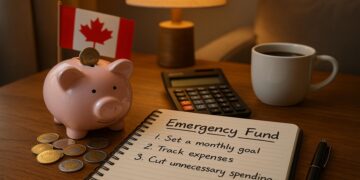How to gradually build an emergency fund

The Importance of an Emergency Fund
Life often throws unexpected challenges our way, and having a financial safety net can make a world of difference. Establishing an emergency fund is not merely a smart choice; it is a vital step towards financial empowerment. This fund enables you to navigate life’s unpredictable circumstances with resilience and assurance.
Let’s delve deeper into why creating an emergency fund is essential:
- Financial security: An emergency fund acts as a cushion against unforeseen events such as sudden job loss, rampant inflation, or unexpected medical expenses. For instance, if you suddenly lose your job in a challenging economic climate, having a financial reserve can help you cover your living expenses while you search for new employment.
- Peace of mind: The knowledge that you have a savings buffer can alleviate anxiety in difficult times. Imagine receiving an enormous medical bill due to an accident or illness; having an emergency fund means you won’t have to panic about how to pay it.
- Better decision-making: With financial padding, you’re free to make choices that align more closely with your long-term goals. Instead of being forced to accept the first job that comes your way due to financial pressures, you can take the time to find a role that truly fits your career aspirations.
In Canada, the sources of unforeseen expenses can vary widely. For example, sudden car repairs due to harsh weather conditions in winter, costly home maintenance, or unexpected dental emergencies can all arise when least expected. Each of these incidents highlights the critical need for a financial cushion.
Building your emergency fund doesn’t have to feel daunting. Start small—perhaps by setting aside a little each month, even if it’s just $50 or $100. As your fund grows, celebrate each milestone. This gradual approach not only fosters savings but also instills essential financial habits that can serve you well throughout life.
Are you ready to take charge of your financial well-being? By taking the initial steps towards creating an emergency fund, you pave the way for future stability, supporting not only your immediate needs but also your dreams and ambitions. Let’s explore the specific actions you can take to build an emergency fund that will provide much-needed relief during life’s inevitable ups and downs.
SEE ALSO: Click here to read another article
Steps to Start Your Emergency Fund Journey
Building an emergency fund is a journey that begins with understanding your financial landscape and setting practical goals. It may seem overwhelming at first, but by taking small, manageable steps, you can establish a financial buffer that provides peace of mind and security. Let’s explore how you can gradually create your emergency fund.
Assess Your Financial Situation
The first step in building an emergency fund is to take an honest look at your current financial situation. Begin by evaluating your monthly income and expenses. This will help you understand how much you can realistically set aside each month. Track your spending for at least a month to identify areas where you can cut back without sacrificing your quality of life. Perhaps you could reduce dining out or limit subscription services, freeing up funds for your emergency savings.
Set a Savings Goal
Next, determine how much money you want to have in your emergency fund. A common rule of thumb is to aim for three to six months’ worth of living expenses. In Canada, consider including potential costs such as housing, utilities, groceries, and transportation in your calculations. However, you can start small; even a goal of $1,000 can provide significant relief in the face of unexpected expenses.
Automate Your Savings
One of the most effective ways to build your emergency fund is to automate your savings. Set up a separate savings account specifically for your emergency fund, and arrange for a portion of your paycheck to be deposited directly into this account. Automating your savings removes the temptation to spend that money and helps you contribute consistently each month. Whether it’s $50 or $200, make it a routine and watch your savings grow.
Establish a Monthly Savings Routine
- Start with a percentage: Decide on a specific percentage of your income to save each month. Even a small percentage, such as 5%, can add up over time.
- Participate in savings challenges: Engage in fun savings challenges, like the 52-week challenge, where you save an increasing amount each week. This not only makes saving interesting but can significantly boost your fund.
- Celebrate your milestones: As you reach savings milestones, celebrate them! Rewards can be simple and cost-effective, such as a favorite meal or a relaxing evening at home. This helps you stay motivated and reinforces positive savings habits.
As you progress in your savings journey, remember that building an emergency fund is a marathon, not a sprint. With determination and consistency, you can create a safety net that brings stability, allowing you to weather life’s storms while pursuing your dreams with confidence. Taking these initial steps not only empowers you financially but also cultivates a mindset of resilience, preparing you for whatever life throws your way.
SEE ALSO: Click here to read another article
Maximizing Your Savings Opportunities
Once you’ve established a routine for saving, the next step is to maximize your savings opportunities. There are various strategies and resources you can leverage to bolster your emergency fund and expedite its growth. From utilizing financial tools to seeking additional income sources, let’s delve into methods that can help you achieve your savings goals more efficiently.
Utilize High-Interest Savings Accounts
When building your emergency fund, consider placing your savings in a high-interest savings account (HISA). These accounts generally offer better interest rates compared to traditional savings accounts, helping your money grow faster over time. In Canada, many banks and credit unions offer HISAs, which are not only secure but also provide easy access to your funds when you need them. Research different financial institutions to find an account that fits your needs, and make the most of your savings by taking advantage of the higher interest rates.
Consider Low-Risk Investment Options
While an emergency fund should primarily be easily accessible, consider placing a portion of your savings in low-risk investment options to help your money grow. Short-term investments like Guaranteed Investment Certificates (GICs) or bond funds can offer better returns than a standard savings account, all while keeping your capital relatively safe. Just ensure that the investments you choose remain stable and can be liquidated quickly in case you need to tap into your emergency fund.
Explore Side Gigs or Passive Income Streams
Another effective strategy to boost your emergency fund is to look into side gigs or passive income streams. Consider utilizing your skills or interests by freelancing, tutoring, or even pet sitting to generate extra cash on the side. Alternatively, investing in dividend-paying stocks or real estate can create passive income that you can funnel directly into your emergency fund. Every dollar counts, and by diversifying your income sources, you can accelerate your savings and achieve your goals faster.
Participate in Employer-Sponsored Savings Plans
If your employer offers a savings plan, such as a Registered Retirement Savings Plan (RRSP) or a Group TFSA, take advantage of it. Some employers provide matching contributions, which can significantly boost your savings. Although these are typically geared towards retirement, you can access funds under specific circumstances. This not only helps you save for an emergency but also instills a habit of regular saving from your paycheck.
Find and Use Cash Windfalls Wisely
Throughout your life, you may encounter unexpected cash windfalls, such as tax refunds, bonuses, or gifts. Instead of splurging these funds, consider allocating a significant portion directly to your emergency fund. By treating these windfalls as opportunities to fortify your savings, you’ll accelerate your progress and feel empowered knowing you’re taking proactive steps toward financial stability.
By incorporating these strategies into your ongoing savings journey, you’ll find that building an emergency fund is not only achievable but also rewarding. Every small step you take brings you closer to financial security and peace of mind, so keep your focus and remember the importance of perseverance. The more you commit to growing your emergency fund, the more secure you will feel—and that sense of security is priceless.
SEE ALSO: Click here to read another article
Embracing the Journey to Financial Security
Building an emergency fund is not just a financial task but a transformative journey towards peace of mind and security. As we have discussed, the key to success lies in gradually establishing a habit of saving and implementing various strategies to maximize your savings potential. From utilizing high-interest savings accounts to exploring low-risk investments and diversifying your income through side gigs, each step contributes to strengthening your financial safety net.
Remember, every small contribution adds up over time. Celebrate the milestones, no matter how minor they may seem, and maintain a steadfast commitment to your goal. Life is unpredictable, and having a robust emergency fund can protect you from unforeseen circumstances—whether it’s an unexpected car repair or a job loss. The empowerment that comes from knowing you have prepared for the unexpected is invaluable.
Moreover, approaching your emergency fund with a pragmatic mindset means being open to opportunities. Consider cash windfalls as a chance to accelerate your savings and take advantage of employer-sponsored plans that can elevate your financial strategy. It’s not just about depositing money; it’s about fostering a mindset geared towards financial resilience.
Ultimately, your journey towards an emergency fund is a testament to your commitment to responsible financial actions. As you cultivate this essential habit, you will not only fortify your finances but also build a foundation of confidence that will carry you through life’s uncertainties. Stay focused, remain optimistic, and embrace the power of incremental progress—your future self will thank you.

Beatriz Johnson is an experienced financial analyst and writer with a passion for simplifying the complexities of business and finance. With over a decade of experience in the industry, she specializes in topics such as personal finance, investment strategies, and global economic trends. Through her work at Great Schedule, Beatriz empowers readers to make informed financial decisions and stay ahead in the ever-changing economic landscape.





